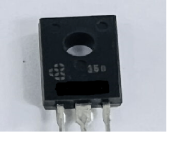Tesla were reputed in the past, my A/c had a capacitor (80/100 MFD) which was a Tesla metal can, Czechoslovakia IIRC.
Trustworthy, really, if it actually a Tesla or Soviet / East German part, for what it was originally marked.
If you use it well below the limits, should work properly.
Trustworthy, really, if it actually a Tesla or Soviet / East German part, for what it was originally marked.
If you use it well below the limits, should work properly.
Who the hell knows? Might even be “real”.
Put it on a 300 volt DC supply collector to emitter, in series with a 100k resistor. Measure the leakage current. If it’s well under 1 uA, go ahead and use them. If not, stick with lower voltage, non-critical useage. Measure the actual vceo (where it zeners) and stay well under it. This sort of test jig won’t blow a 2N3904. It’s not good for it, as you can degrade the hFE and noise over time with the test.
Put it on a 300 volt DC supply collector to emitter, in series with a 100k resistor. Measure the leakage current. If it’s well under 1 uA, go ahead and use them. If not, stick with lower voltage, non-critical useage. Measure the actual vceo (where it zeners) and stay well under it. This sort of test jig won’t blow a 2N3904. It’s not good for it, as you can degrade the hFE and noise over time with the test.
Is this a relatively safe way to determine the Vceo rating in general?Put it on a 300 volt DC supply collector to emitter, in series with a 100k resistor. Measure the leakage current. If it’s well under 1 uA, go ahead and use them.
Best regardfs!
Yes, it actually is. Keep Pdiss under control, and keep the test short. I used to grade “ungraded” TIPs, salvage, and grab-bag parts from Poly-Paks that way. As well as using Radio Shack parts above Vceo. The old RCA data books used to explicitly state against testing “on a curve tracer” because you can very easily get it into second breakdown as the current rapidly climbs. Limit with a high value resistor or current source and the only thing you could do to it is degrade the hFE. Don’t grade low noise input stages that way. But i have graded 2N3904’s and 2SC945’s for higher voltage operation this way and had them still work as expected. Was the noise figure degraded? No idea. Theory tells you it would, but it didn’t make anything hiss more than I’d expect. If an application is critical, you just don’t resort to these tactics.
This will not tell you anything about second breakdown. But no TO-92 known to Man as its S/B limit inside of its Ta limited thermal limits. Tc yes, but that’s not how you use parts like this. When you have to go heat sinking a TO-92 you’re using something too small to begin with. It’s very tempting to use the simple vceo to determine “what I can put on this unknown or potentially fake TO-3”. It must be supplemented by an operational test, such as a 50V/3A test jig. That was my old “golden standard” in the early days - it passes that and you can make an amp out of it. It fails, nothing is really lost…..
This will not tell you anything about second breakdown. But no TO-92 known to Man as its S/B limit inside of its Ta limited thermal limits. Tc yes, but that’s not how you use parts like this. When you have to go heat sinking a TO-92 you’re using something too small to begin with. It’s very tempting to use the simple vceo to determine “what I can put on this unknown or potentially fake TO-3”. It must be supplemented by an operational test, such as a 50V/3A test jig. That was my old “golden standard” in the early days - it passes that and you can make an amp out of it. It fails, nothing is really lost…..
For the transistor yes. For you be very careful, 300Vdc can easily kill.Is this a relatively safe way to determine the Vceo rating in general?
Best regardfs!
Beware that a type AC 30mA RCCD won't protect you.
There is one thing that is worse than getting 60-hertzed and that’s getting hit with DC. Connect the transistor unpowered, get your fingers away, then throw the switch.For the transistor yes. For you be very careful, 300Vdc can easily kill.
Beware that a type AC 30mA RCCD won't protect you.
DC may 'hit' harder but AC is more dangerous as the heart muscle can be sent into fibrilation by the 50 or 60 Hz current far more easily, the difference is a factor of 10 or more.
In our electrical norms, the limit for when a voltage is 'safe' is set at 50 Vac and 120 Vdc. With wet skin, it would be wise to halve these values to 25 Vac and 60 Vdc
Please note that AC voltages are usually given as an RMS value, the peak value is obtained by multiplying by 1.414 (square root of 2). It is always safe practice to work on circuits disconnected from mains power (and proven - not assumed - to be dead). Also make sure capacitors are discharged!
In our electrical norms, the limit for when a voltage is 'safe' is set at 50 Vac and 120 Vdc. With wet skin, it would be wise to halve these values to 25 Vac and 60 Vdc
Please note that AC voltages are usually given as an RMS value, the peak value is obtained by multiplying by 1.414 (square root of 2). It is always safe practice to work on circuits disconnected from mains power (and proven - not assumed - to be dead). Also make sure capacitors are discharged!
Last edited:
DC is more likely to convulse your muscles so you can't let go, the main reason it is considered much more dangerous I think. People differ in their susceptibility to shock by large factors too, the same voltage could fatal to one person, a nuisance to another. So its simple, don't take any risks above about 50V and never work with electricity with wet hands.
Wet skin will greatly reduce safe voltages, 60Vdc with wet skin will give a real shock (don't try this!). You may have experienced the unpleasant sensation of a 9V battery on the tongue, that's only 9V on wet skin! Even very low DC on wet skin will cause electrolysis and generate chlorine, although this is a much slower process of injury.
Wet skin will greatly reduce safe voltages, 60Vdc with wet skin will give a real shock (don't try this!). You may have experienced the unpleasant sensation of a 9V battery on the tongue, that's only 9V on wet skin! Even very low DC on wet skin will cause electrolysis and generate chlorine, although this is a much slower process of injury.
There is no one value that is the safe/unsafe boundary.
Risk come into it, so the European safety regulations require 30 mA RCCDs to your power sockets, but only 10 mA RCCD when water is involved like electric showers.
The voltage limits have always been a bit of a fudge to avoid 48V telephone lines being classed as hazardous.
Risk come into it, so the European safety regulations require 30 mA RCCDs to your power sockets, but only 10 mA RCCD when water is involved like electric showers.
The voltage limits have always been a bit of a fudge to avoid 48V telephone lines being classed as hazardous.
Looks refurbished, pins are soldered or welded.Can anyone identify this brand?
Thanks!
Bud maybe I wrong.
Hi,
I just bought 4 pcs of 2SK2013 from physical shop in Zagreb (for 6 Euro per piece) which are obvious fakes, Vgs measures 3,6 - 3,8 V instead of around 2 V. Pictures are on this post:
https://www.diyaudio.com/community/...ttle-fb-160watt-amplifier.412261/post-7675832
Also this thread published almost the same photos of fakes like mine:
https://www.diyaudio.com/community/threads/fake-or-real-2sk2013.344965/
I really wonder how EU commission and custom offices of all countries in EU (that usually torture citizens about benign birthday presents coming from my sister that lives in Australia) allow this massive import of counterfeits from we guess where????
I just bought 4 pcs of 2SK2013 from physical shop in Zagreb (for 6 Euro per piece) which are obvious fakes, Vgs measures 3,6 - 3,8 V instead of around 2 V. Pictures are on this post:
https://www.diyaudio.com/community/...ttle-fb-160watt-amplifier.412261/post-7675832
Also this thread published almost the same photos of fakes like mine:
https://www.diyaudio.com/community/threads/fake-or-real-2sk2013.344965/
I really wonder how EU commission and custom offices of all countries in EU (that usually torture citizens about benign birthday presents coming from my sister that lives in Australia) allow this massive import of counterfeits from we guess where????
- Home
- Design & Build
- Parts
- My Transistors, original or copy?

